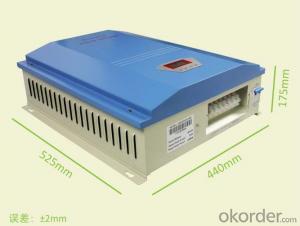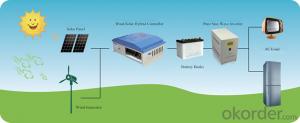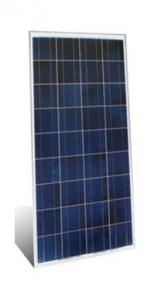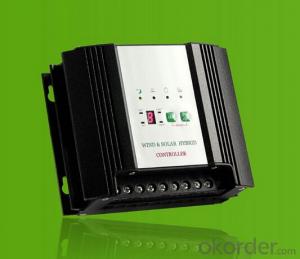Wind Solar Hybrid Controller 3KW PWM Stepless Unload Mode
- Loading Port:
- Shanghai
- Payment Terms:
- TT or LC
- Min Order Qty:
- 1 unit
- Supply Capability:
- 5000 unit/month
OKorder Service Pledge
OKorder Financial Service
You Might Also Like
I. PRODUCT INTRODUCTION
The wind/solar hybrid controller is the control device which can control wind turbine and solar panel at the same time and transform wind and solar energy into electricity then stores to the battery bank.Wind/solar hybrid controller is the most important part in off-grid system, whose performance has much effect on life expectancy and operational stability of the whole system, especially the battery expectancy. Or battery service life will be shortened by over-charge or over-discharge.
II. PERFORMANCE FEATURES
Superior military-grade components to ensure the product stability.
Perfect protection function, thus the system has higher reliability.
Check and set all operation parameters as requirement from LCD display.
Voltage limiting and current-limiting charge mode ensures battery in the best charging status.
PWM stepless unload mode, which burn the excess power into dump load, making the battery charging in best status.
III. APPLICATION AREAS
Stand alone wind/solar hybrid power station; Stand alone domestic household wind/solar hybrid power system.
Mobile communication base stations, expressway and other non-residential regions.
Coastal islands, remote mountainous, border posts for regions shortage of or without electricity.
Government demonstration projects, landscape lighting project.
IV. 3KW TECHNICAL PARAMETERS
Product Model | WWS30-48 | WWS30-96 | WWS30-110 | WWS30-120 | WWS30-220 |
Rated Battery Voltage | 48 V | 96 V | 110V | 120 V | 220 V |
Rated Wind Turbine Input Power | 3 kW | 3 kW | 3kW | 3 kW | 3 kW |
Maximum Wind Turbine Input Power | 4.5 kW | 4.5 kW | 4.5kW | 4.5 kW | 4.5 kW |
Wind Turbine Brake Current | 63 A | 32 A | 28A | 25 A | 14 A |
Rated Solar Input Power | 0.9 kW | 0.9 kW | 0.9kW | 0.9 kW | 0.9 kW |
Floating Charging Voltage | 58 V | 116 V | 133V | 145 V | 266 V |
Dimension(L x W x H) | 442×525×172 mm | ||||
Net Weight | 15kg | ||||
Display Mode | LCD | ||||
Cooling | Fan | ||||
Protection Level | IP20(Indoor) | ||||
Quiescent Current | ≤20 mA | ||||
Protection functions | Battery over charge; Battery over discharge; solar reverse charge protection; anti-reverse-connection protection; wind turbine over rotate speed protection; wind turbine over wind speed protection; wind turbine over voltage protection; wind turbine over current protection; manual brake protection; automatically brake protection; lightning protection. | ||||
Ambient Temperature | -20~+55℃ | ||||
Ambient Humidity | 0~93%, without condensing | ||||
Working humidity | ≤4000m | ||||
In order to serve our customers better. Our company can adjust parameters configuration according to customer’s requirement. | |||||
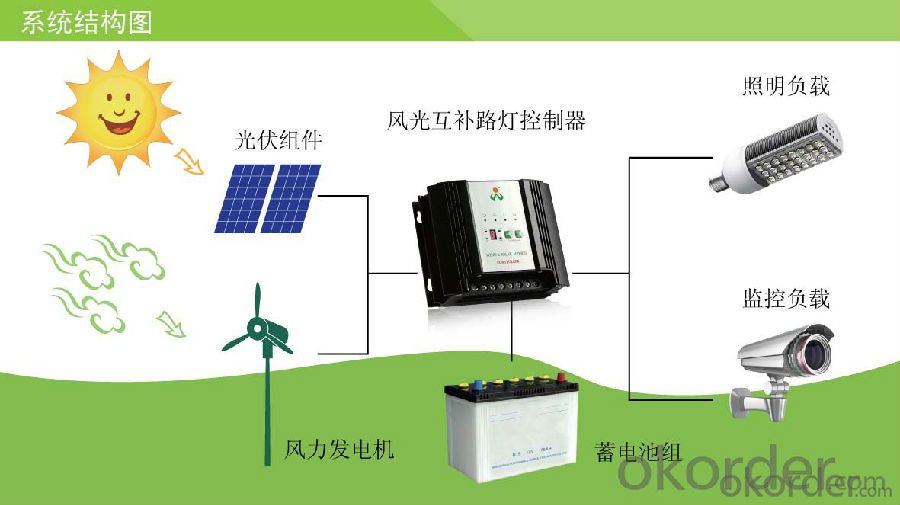
- Q:How does a solar controller handle variations in ambient light conditions?
- A solar controller handles variations in ambient light conditions by continuously monitoring the incoming solar energy and adjusting the charging parameters accordingly. It uses sensors to measure the intensity of light and adjusts the charging current and voltage to optimize the charging efficiency and protect the battery from overcharging or undercharging.
- Q:How does a solar controller handle the protection against short circuits?
- A solar controller handles protection against short circuits by incorporating various safety measures. It typically includes built-in fuses or circuit breakers that can automatically disconnect the solar panel or battery from the controller in case of a short circuit. This helps to prevent damage to the system and ensures the safety of connected devices. Additionally, some solar controllers also employ advanced technologies like pulse width modulation (PWM) or maximum power point tracking (MPPT) algorithms, which continuously monitor the current flow and adjust it to maintain optimal performance while protecting against short circuits.
- Q:What is the maximum number of system data logs supported by a solar controller?
- The maximum number of system data logs supported by a solar controller depends on the specific model and manufacturer. It can vary significantly, ranging from a few hundred to several thousand logs. It is important to consult the product specifications or contact the manufacturer for accurate information regarding the maximum number of system data logs supported.
- Q:How does a solar controller handle battery float charging?
- A solar controller handles battery float charging by regulating the amount of charge sent to the battery once it reaches its maximum capacity. It maintains a constant voltage level to prevent overcharging and provides a trickle charge to keep the battery fully charged without causing any damage.
- Q:What is the typical warranty period for a solar controller?
- The typical warranty period for a solar controller can vary depending on the brand and model. However, most reputable solar controller manufacturers offer warranties that range from 1 to 5 years. Some higher-end controllers may even come with extended warranties of up to 10 years. It is important to carefully check the warranty terms and conditions provided by the manufacturer before purchasing a solar controller to ensure that it meets your specific needs and expectations.
- Q:How do I protect a solar controller from electromagnetic interference?
- To protect a solar controller from electromagnetic interference, you can take a few measures. Firstly, make sure the controller is installed in a location away from other electronic devices that emit electromagnetic radiation. This will minimize the chances of interference. Additionally, using shielded cables and grounding the system properly can help reduce electromagnetic interference. Lastly, you may consider using ferrite beads or filters to suppress any potential interference.
- Q:Can a solar controller be used in a solar-powered electric motorbike racing system?
- Yes, a solar controller can be used in a solar-powered electric motorbike racing system. A solar controller regulates and optimizes the charging process of the solar panels, ensuring efficient energy transfer to the batteries. In a solar-powered racing system, the solar controller would play a crucial role in managing the energy flow, maximizing the performance and longevity of the batteries, and ultimately enhancing the overall efficiency of the motorbike.
- Q:Can a solar controller be used in both off-grid and grid-tied systems?
- No, a solar controller cannot be used in both off-grid and grid-tied systems. Off-grid systems require a solar controller to manage the battery charging and discharging process, while grid-tied systems do not use batteries and therefore do not require a solar controller.
- Q:What is the maximum cable size that can be used between the solar panels and the load?
- The maximum cable size that can be used between the solar panels and the load depends on various factors such as the distance between the panels and the load, the amount of power being generated by the panels, and the electrical specifications of the load. It is best to consult the manufacturer's guidelines or seek advice from a qualified electrician or solar professional to determine the appropriate cable size for your specific system.
- Q:Can a solar controller be used with solar panels of different materials?
- Solar controllers can indeed be used with solar panels made from different materials. Their main task is to regulate the flow of voltage and current from the solar panels to the battery or grid, and this function is not affected by the material of the panels. Regardless of whether the solar panels are composed of monocrystalline, polycrystalline, thin-film, or any other material, the solar controller will effectively carry out its duties. However, it is crucial to verify that the solar controller is compatible with the specific voltage and current requirements of the solar panels in use.
1. Manufacturer Overview |
|
|---|---|
| Location | |
| Year Established | |
| Annual Output Value | |
| Main Markets | |
| Company Certifications | |
2. Manufacturer Certificates |
|
|---|---|
| a) Certification Name | |
| Range | |
| Reference | |
| Validity Period | |
3. Manufacturer Capability |
|
|---|---|
| a)Trade Capacity | |
| Nearest Port | |
| Export Percentage | |
| No.of Employees in Trade Department | |
| Language Spoken: | |
| b)Factory Information | |
| Factory Size: | |
| No. of Production Lines | |
| Contract Manufacturing | |
| Product Price Range | |
Send your message to us
Wind Solar Hybrid Controller 3KW PWM Stepless Unload Mode
- Loading Port:
- Shanghai
- Payment Terms:
- TT or LC
- Min Order Qty:
- 1 unit
- Supply Capability:
- 5000 unit/month
OKorder Service Pledge
OKorder Financial Service
Similar products
New products
Hot products
Hot Searches
Related keywords
